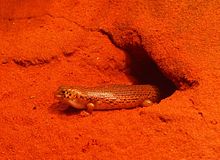Desert egernia
It has a pale, creamy white-to-yellow underside and white ventral area and its limbs are often paler than the rest of the body.
[6] The tail of the desert egernia is usually slightly longer than the snout-vent length of the lizard, is round and tapering, similarly coloured to the body with little variation.
[11] Due to its large range and relative abundance, the desert egernia has been assessed as being of 'Least Concern' of endangerment by the IUCN Red List.
[12] The desert egernia is protected by state legislation in Victoria, designated threatened due to its small range.
[3][15] The desert egernia typically resides in areas with deep, uncompacted sandy/loamy soils and is more likely to exist higher on sand ridges than close relatives occurring within a similar range, such as the Night Skink (Liopholis striata).
The burrow is usually between 30 cm-50 cm deep, and is characterised by a pattern of fanned sand surrounding at least one entrance or occasionally piled within a nearby clump of grass.
[16] The remainder of the diet of the desert egernia consists of larger insects such as spiders and beetles, and occasionally plant material and other lizards.
[7] The desert egernia is also frequently preyed upon by introduced mammals such as cats and foxes, who are able to identify its presence within an area by its distinctive burrows.
[3] The tendency of the desert egernia to frequently change burrow sites may be an adaption to predation by these species.



